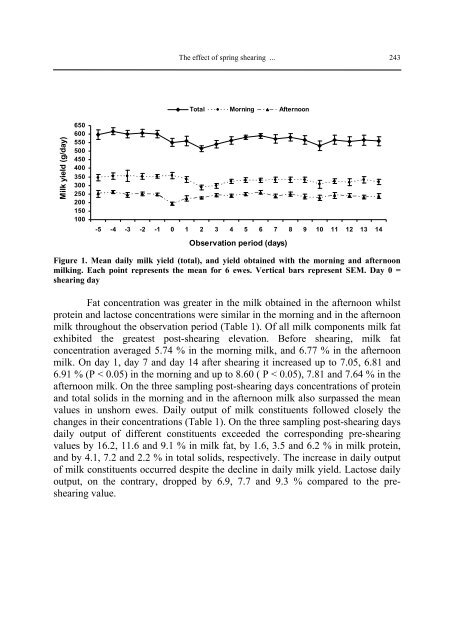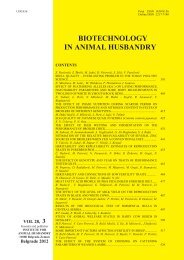Biotechnology in Animal Husbandry - Institut za Stočarstvo
Biotechnology in Animal Husbandry - Institut za Stočarstvo
Biotechnology in Animal Husbandry - Institut za Stočarstvo
You also want an ePaper? Increase the reach of your titles
YUMPU automatically turns print PDFs into web optimized ePapers that Google loves.
Milk yield (g/day)<br />
650<br />
600<br />
550<br />
500<br />
450<br />
400<br />
350<br />
300<br />
250<br />
200<br />
150<br />
100<br />
The effect of spr<strong>in</strong>g shear<strong>in</strong>g ...<br />
Total Morn<strong>in</strong>g Afternoon<br />
-5 -4 -3 -2 -1 0 1 2 3 4 5 6 7 8 9 10 11 12 13 14<br />
Observation period (days)<br />
Figure 1. Mean daily milk yield (total), and yield obta<strong>in</strong>ed with the morn<strong>in</strong>g and afternoon<br />
milk<strong>in</strong>g. Each po<strong>in</strong>t represents the mean for 6 ewes. Vertical bars represent SEM. Day 0 =<br />
shear<strong>in</strong>g day<br />
Fat concentration was greater <strong>in</strong> the milk obta<strong>in</strong>ed <strong>in</strong> the afternoon whilst<br />
prote<strong>in</strong> and lactose concentrations were similar <strong>in</strong> the morn<strong>in</strong>g and <strong>in</strong> the afternoon<br />
milk throughout the observation period (Table 1). Of all milk components milk fat<br />
exhibited the greatest post-shear<strong>in</strong>g elevation. Before shear<strong>in</strong>g, milk fat<br />
concentration averaged 5.74 % <strong>in</strong> the morn<strong>in</strong>g milk, and 6.77 % <strong>in</strong> the afternoon<br />
milk. On day 1, day 7 and day 14 after shear<strong>in</strong>g it <strong>in</strong>creased up to 7.05, 6.81 and<br />
6.91 % (P < 0.05) <strong>in</strong> the morn<strong>in</strong>g and up to 8.60 ( P < 0.05), 7.81 and 7.64 % <strong>in</strong> the<br />
afternoon milk. On the three sampl<strong>in</strong>g post-shear<strong>in</strong>g days concentrations of prote<strong>in</strong><br />
and total solids <strong>in</strong> the morn<strong>in</strong>g and <strong>in</strong> the afternoon milk also surpassed the mean<br />
values <strong>in</strong> unshorn ewes. Daily output of milk constituents followed closely the<br />
changes <strong>in</strong> their concentrations (Table 1). On the three sampl<strong>in</strong>g post-shear<strong>in</strong>g days<br />
daily output of different constituents exceeded the correspond<strong>in</strong>g pre-shear<strong>in</strong>g<br />
values by 16.2, 11.6 and 9.1 % <strong>in</strong> milk fat, by 1.6, 3.5 and 6.2 % <strong>in</strong> milk prote<strong>in</strong>,<br />
and by 4.1, 7.2 and 2.2 % <strong>in</strong> total solids, respectively. The <strong>in</strong>crease <strong>in</strong> daily output<br />
of milk constituents occurred despite the decl<strong>in</strong>e <strong>in</strong> daily milk yield. Lactose daily<br />
output, on the contrary, dropped by 6.9, 7.7 and 9.3 % compared to the pre-<br />
shear<strong>in</strong>g value.<br />
243




